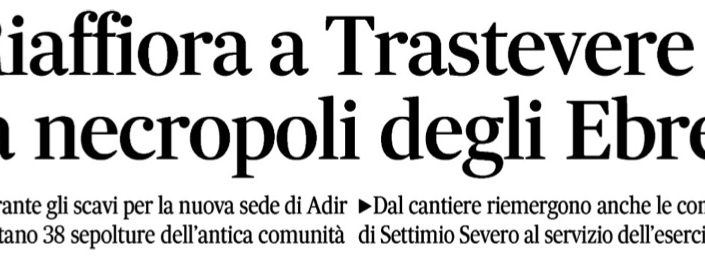(Rome, March 20th, 2017). The Trastevere neighborhood in Rome, the low-lying area on the Tiber River's right bank below the precipitous slopes of the Janiculum and Monteverde, has been associated with Jews since the time of the ancient Roman Republic. The literary record is not extensive for Jews at the local level, but it is very old. Likewise, material traces of Jews in this region are largely restricted to artifacts from burial grounds, with the exception of some objects and texts from the early Modern era that today are housed in collections like Rome's Jewish Museum.
This trend of recovering essential data about Rome's Jewish communities of two millennia and more from mortuary remains continues with the announcement by Italian archaeologists during a March 20th press conference at the National Museum of Rome at Palazzo Massimo of their discovery of thirty-eight tombs from a Jewish cemetery in Trastevere which dates to the Late Medieval and Early Modern eras (fourteenth through early seventeenth centuries).
The excavations were carried out over a period of six years during the restoration of the Palazzo Leonori on the viale delle Mura Portuensi, the new administrative center of the Rome-based insurance agency, le Assicurazioni di Roma (AdiR). Digging to a depth of eight meters below the modern ground level in some spots, both inside and outside of the present day, Fascist-era structure, the archaeologists reached the site of the Campus Judaeorum, the "Field (cemetery) of the Jews", and even some Roman-era industrial remains, identified as the "Coraria Septimiana", the workspace instituted by the emperor Septimius Severus around the turn of the third century for the tanners' guild (it is worth noting that Rome's topography was linked always to its sustainability: this area was, in fact, the "Bufalara", the loading dock for animals, especially cattle, over a thousand years later).
The photographs in the March 22, 2017 edition of the Italian daily, Il Messaggero, show these tombs as individual troughs arranged in rows, or up against older ruins (which remained visible in the cemetery); the skeletons, for the most part of adult males, seem well-preserved, but they stand alone: a good part of what could be taken away from the site, like the headstones, was removed at the time new defensive walls for the city were built over the site, and the bodies themselves originally seem to have been encased in wooden coffins that have since disintegrated into the soil. Only one fragment of an epitaph in Hebrew emerged from the recent excavation, but others have come to light over the years, especially during the late nineteenth century, in a secondary use, as a 1625 edict of Pope Urban VIII not only forbade the erection of new tombstones, but also sanctioned the destruction of existing Jewish grave markers. As fate would have it, not even a decade later, the first published notice of an ancient Jewish catacomb, or underground cemetery, occurred in a posthumous work of Antonio Bosio, the Roma Sotterranea (1632-34), documenting the existence of an even earlier burial grounds for Roman Jews on the southern slope of the Monteverde, a mile or so from the Palazzo Leonori site, which Bosio was able to enter and partially explore in 1602. His account of the catacomb included, in fact, specific reference to the Trastevere cemetery, the Campo dei Giudei, that still retained its name and apparently - as we know now, thanks to the recent excavations - many of its graves.
The present study of the graves below the Palazzo Leonori involved many different specialists, who have contributed an important chapter in the history of the daily conditions for Jews under Papal Rule in Rome. This is the first time, in fact, that photographs and other documentation of the tombs have been made public, confirming that not all is lost of the hallowed grounds. Part of the archaeological site will be visible below glass in a covered courtyard, and can be visited upon request. Details are forthcoming from the Italian State Archaeological Offices (http://archeoroma.beniculturali.it/en).
Sources: Laura Larcan, "Raffiora a Trastevere la necropoli degli Ebrei," in Il Messaggero, 22 marzo 2017, p. 55: http://www.ilmessaggero.it/roma/cronaca/trastevere_necropoli_ebrei-2332354.html; "Coraria Septimiana e Campus Iudeorum: Novita dai Recenti Scavi," International Catacomb Society, March 18th, 2017: https://www.catacombsociety.org/coraria-septimiana-e-campus-iudeorum-novita-dai-recenti-scavi-fuori-porta-portese/; Jessica Dello Russo, unpublished thesis.
